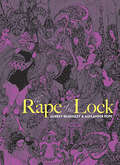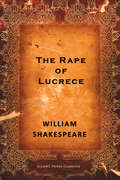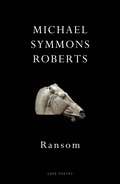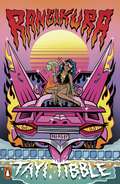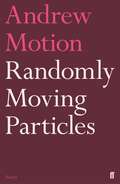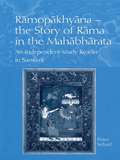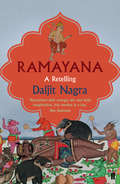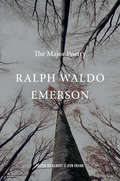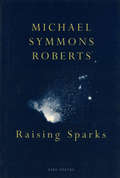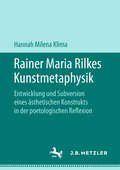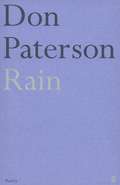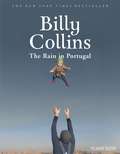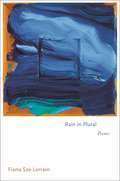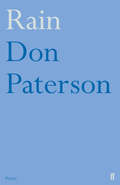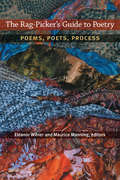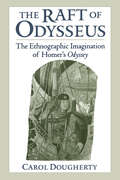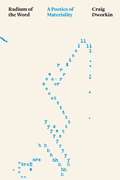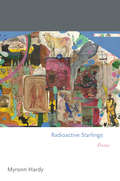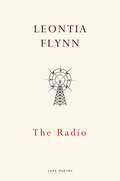- Table View
- List View
The Rape of the Lock: An Heroi-comical Poem... (Dover Fine Art, History Of Art Series)
by Alexander Pope Aubrey BeardsleyOnly rarely in publishing history has the ideal edition of a literary work been created, where text, typography, and illustrations complement one another perfectly. Among the few examples are the Kelmscott Chaucer, Baskerville's Milton, and Beardsley's Salome. Another such book is the 1896 edition of Pope's The Rape of the Lock, illustrated by Aubrey Beardsley.Beardsley's elaborate drawings for The Rape of the Lock were created during the last phase of his brief career. This nearly Romantic period, characterized by rich, brilliantly imagined decoration and ornamentation and by high textual contrasts, was perfectly suited to the blend of mock-heroic, satire, and delicate fancy of Pope's poems. As Beardsley's biographer R. A. Walker wrote, "These drawings show a verve, a wit and appreciation of the poem than can scarcely be matched in English literature." Using his unique line and "black blot" technique, Beardsley created a masterpiece of design and mood.This Dover edition reproduces the first edition: the complete text of the five-canto poem, notes, seven full-page drawings, two half-page drawings, and the original cover design by Beardsley.
The Rape of Lucrece
by William ShakespeareWhen the king's son hears the chastity of one of his father's advisors praised, he sets out to sully her name, with tragic consequences.
Ransom
by Michael Symmons Roberts*A FINANCIAL TIMES 'BOOKS OF 2021' PICK*Ransom, the new collection from Michael Symmons Roberts, is an intense and vivid exploration of liberty and limit, of what it means to be alive, and searches for the possibility of hope in a fallen, wounded world. The poems in Ransom display all the lyrical beauty and metaphysical ambition for which his work is acclaimed, but with a new urgency, a ragged edge to what the Independent described as his 'dazzling elegance'. At the heart of this new book are three powerful sequences - one set in occupied Paris, one an elegy for his father, and one a meditation on gratitude - that work at the edges of belief and doubt, both mystical and philosophical. The idea of 'ransom' is turned and turned again, poem by poem, seen through the lenses of personal grief and loss, cinematic scenes of kidnap and release, narratives of incarnation and atonement. This is a profound and timely book from one of our finest poets.
Rangikura
by Tayi TibbleMaori mythology and endless summers: the sparkling second collection from a daring new poetic voiceI am made in the image of my mother ...I am made in the image of / my mountain / my river / my whenuaIn Rangikura, plastic tiaras melt into boiling rivers, and family memories blur with ancestral mythologies. Satanic stepbrothers play jenga while the deity Mahuika burns - and the temperature is rising. Here, anger and loss, history and pop culture are spun into verses woven with vernacular and Te Reo Maori. At the collection's centre, our protagonist whirls through a love/hate story for the internet age, facing the sting of unanswered texts and unmet expectations with wit, sensibility and devastating glamour.Rangikura is the captivating second collection from award-winning poet Tayi Tibble. From feminism to colonialism, skuxes to daddies, wild swimming to schoolboy hakas, these poems at once mark the end of the world and the dawn of a new day. Poignant, hilarious and liberatory, Rangikura reminds us that the personal is sometimes political, the political is always personal, and poetry can be revolutionary.
Randomly Moving Particles
by Sir Andrew MotionAndrew Motion's expansive new collection is built around two long poems that form its opening and close. The title poem, in a kaleidoscope of compelling scenes, engages with subjects that include migration, placement, loss, space exploration and current British and American politics. The more straightforwardly narrative poem, 'How Do the Dead Walk', while reaching back to immemorial stories of brutality, addresses issues of contemporary violence. The book is direct in its emotional appeal, ambitious in its scope, all the while retaining the cinematic vision and startling expression that so freshly lit the lines of his last, Essex Clay.
Ramopakhyana - The Story of Rama in the Mahabharata: A Sanskrit Independent-Study Reader
by Peter ScharfThe most popular story in all of India and a classic of world literature is summarised in 728 verses in the great epic Mahabharata. Intended for independent study or classroom use for students of various levels who have had a basic introduction to Sanskrit, this fully annotated edition of the Ramopakhyana supplies all the information required for complete comprehension. It contains the Devanagari text, Roman transliteration, sandhi analysis, Sanskrit prose equivalents to the verses, syntactic and cultural notes, and the English translation, and word-by-word grammatical analysis.
Ramopakhyana - The Story of Rama in the Mahabharata: A Sanskrit Independent-Study Reader
by Peter ScharfThe most popular story in all of India and a classic of world literature is summarised in 728 verses in the great epic Mahabharata. Intended for independent study or classroom use for students of various levels who have had a basic introduction to Sanskrit, this fully annotated edition of the Ramopakhyana supplies all the information required for complete comprehension. It contains the Devanagari text, Roman transliteration, sandhi analysis, Sanskrit prose equivalents to the verses, syntactic and cultural notes, and the English translation, and word-by-word grammatical analysis.
Ramayana
by Daljit NagraAttributed to Valmiki, thought to be India's first poet, the Ramayana's origins date back thousands of years when it was first committed to Sanskrit. Since then, generations of children the world over have grown up with its story of Rama's quest to recover his wife Sita from her abduction by Raavana, the Lord of the Underworld. The tale has been celebrated in many languages and has spread to many other countries including Nepal, Tibet, Thailand, Burma, Laos, Cambodia, Malaysia and Indonesia. It is used as a Hindu, Jain, Buddhist, Islamic, Sikh as well as a secular text, and lives in in many art forms too: in drama and dance, in sculpture and painting, in prose and in poetry. Daljit Nagra was captivated by the versions his grandparents regaled him with as a child. Now an award-winning poet of dazzling gifts, he has chosen to bring the story to life in a vivid and enthralling version of his own. Accessible and engaging, and bursting with energy, Nagra's Ramayana is a distillation and an animation for readers of all ages, whether familiar with or entirely new to this remarkable tale.
Ralph Waldo Emerson: The Major Poetry
by Ralph Waldo Emerson"Ralph Waldo Emerson: The Major Poetry "presents a selection of definitively edited texts that remind us why Emerson s poetry matters and why he remains one of our most important theoreticians of verse. Drawn chiefly from the multivolume "Collected Works, "each poem is accompanied by a headnote for the student and general reader."
Raising Sparks (Cape Poetry Ser.)
by Michael Symmons RobertsAfter his first collection - SOFT KEYS - Michael Symmons Roberts was hailed by Les Murray as 'a poet for the new, chastened, unenforcing age of faith that has just dawned'. The metaphysical concerns of that first book are central to this new collection, written in a language at once philosophical, sensuous and lyrical. From a doctor who washes lungs to the structure of genes, from mythical hounds born to fire to a cat's-eye souvenir from a smashed-up road, the scope of this collection is impressive. Whatever the subject, these poems are concerned with elemental themes, with the mapping of experience, and the search for sparks of life at its heart. At the heart of RAISING SPARKS are two sequences - 'Smithereens' and 'Quickenings' - which form part of a continuing collaboration with the composer James MacMillan; the former set as a song cycle and the latter as amajor choral piece. These sequences - alongside intamate lyrics and dramatic meditations on creation, redemption and the end of time - show a poet of enormous range and depth.
Rainer Maria Rilkes Kunstmetaphysik
by Hannah Milena KlimaMit seinen Texten geht Rainer Maria Rilke der Spur einer ‚Essenz‘ des Lebens nach. In seinen Werken ist die Überzeugung eingeschrieben, dass das Kunstwerk eine metaphysische Wahrheit transportiert, die sich jedoch ihrerseits schwer fassen lässt und beständig „im Schwinden steht“. Hannah Milena Klima etabliert die These, dass Rilke in der poetologischen Reflexion eine ‚Kunstmetaphysik‘ entwickelt, worunter die Gesamtheit aller Reflexionen, die auf ein Höheres in der Kunst verweisen, verstanden wird, und die sich mit dem Begriff des unbedrängten „Weltinnenraums“ fassen lassen könnte. Es wird aufgezeigt, wie dieses Konzept auf poetologischen Prämissen basiert und wie es sich im Verlauf des Gesamtwerks verändert.
Rain (PDF)
by Don PatersonIn this, his first volume of original verse since the award-winning Landing Light, Don Paterson is found writing at his most memorable and direct. In an assembly of masterful lyrics and monologues, he conjures a series of fables and charms that serve both to expose us to the unsettling forces within the world and simultaneously offer some protection against them. Whether outwardly elemental in their address, or more personal in their direction, these poems - to the rain and the sea, to his young sons or beloved friends - never shy from their inquiry into truth and lie, embracing everything in scope from the rangy narrative to the tiny renku. Rain, which includes the winner of this year's Forward Prize for the Best Individual Poem and an extended elegy for the poet Michael Donaghy, is Don Paterson's most intimate and manifest collection to date.
The Rain in Portugal: Poems
by Billy CollinsFrom former U.S. Poet Laureate Billy Collins comes a twelfth collection of poetry offering nearly fifty new poems that showcase his trademark generosity, wit, and imaginative play.
Rain in Plural: Poems (Princeton Series of Contemporary Poets #154)
by Fiona Sze-LorrainThe highly anticipated new collection from a poet whose previous book was a finalist for the Los Angeles Times Book PrizeRain in Plural is the much-anticipated fourth collection of poetry by Fiona Sze-Lorrain, who has been praised by The Rumpus as "a master of musicality and enlightening allusions." In the wholly original world of these new poems, Sze-Lorrain addresses both private narratives and the overexposed discourse of the polis, using silence and montage, lyric and antilyric, to envision what she calls "creating between liberties." With a moral precision embracing us without eschewing I, she rethinks questions of citizenship, the selections of sensory memory, and, by extension, the tether of word and image to the actual. She writes, "I accept the truth in newspapers / by holding the murder of my friends against my chest. // To each weather forecast I give thanks: / merci for every outdated // dusk/dawn." Agrippina the Younger, Franz Kafka, Bob Dylan, a butoh performance, an unnamed Raku tea bowl—each has a place here. Made whole by time and its alteration in timelessness, synchrony, coincidences, and accidents, Rain in Plural beautifully reveals an elegiac yet ever-evolving inner life.
Rain in Plural: Poems (Princeton Series of Contemporary Poets #154)
by Fiona Sze-LorrainThe highly anticipated new collection from a poet whose previous book was a finalist for the Los Angeles Times Book PrizeRain in Plural is the much-anticipated fourth collection of poetry by Fiona Sze-Lorrain, who has been praised by The Rumpus as "a master of musicality and enlightening allusions." In the wholly original world of these new poems, Sze-Lorrain addresses both private narratives and the overexposed discourse of the polis, using silence and montage, lyric and antilyric, to envision what she calls "creating between liberties." With a moral precision embracing us without eschewing I, she rethinks questions of citizenship, the selections of sensory memory, and, by extension, the tether of word and image to the actual. She writes, "I accept the truth in newspapers / by holding the murder of my friends against my chest. // To each weather forecast I give thanks: / merci for every outdated // dusk/dawn." Agrippina the Younger, Franz Kafka, Bob Dylan, a butoh performance, an unnamed Raku tea bowl—each has a place here. Made whole by time and its alteration in timelessness, synchrony, coincidences, and accidents, Rain in Plural beautifully reveals an elegiac yet ever-evolving inner life.
Rain: Poems
by Don PatersonIn this, his first volume of original verse since the award-winning Landing Light, Don Paterson is found writing at his most memorable and direct. In an assembly of masterful lyrics and monologues, he conjures a series of fables and charms that serve both to expose us to the unsettling forces within the world and simultaneously offer some protection against them. Whether outwardly elemental in their address, or more personal in their direction, these poems - to the rain and the sea, to his young sons or beloved friends - never shy from their inquiry into truth and lie, embracing everything in scope from the rangy narrative to the tiny renku. Rain, which includes the winner of this year's Forward Prize for the Best Individual Poem and an extended elegy for the poet Michael Donaghy, is Don Paterson's most intimate and manifest collection to date.
The Rag-Picker's Guide to Poetry: Poems, Poets, Process
by Eleanor Wilner Maurice ManningThe venture of this inviting collection is to look, from the many vantages that the 35 poets in this eclectic anthology chose to look, at what it was—knowing that a poem can’t be conceived in advance of its creation—that helped their poems to emerge or connected them over time. The Rag-Picker's Guide to Poetrypermits an inside view of how poets outwit internal censors and habits of thought, showing how the meticulous and the spontaneous come together in the process of discovery. Within are contained the work and thoughts of: Betty Adcock Joan Aleshire Debra Allbery Elizabeth Arnold David Baker Rick Barot Marianne Boruch Karen Brennan Gabrielle Calvocoressi Michael Collier Carl Dennis Stuart Dischell Roger Fanning Chris Forhan Reginald Gibbons Linda Gregerson Jennifer Grotz Brooks Haxton Tony Hoagland Mark Jarman A. Van Jordan Laura Kasischke Mary Leader Dana Levin James Longenbach Thomas Lux Maurice Manning Heather McHugh Martha Rhodes Alan Shapiro Daniel Tobin Ellen Bryant Voigt Alan Williamson Eleanor Wilner C. Dale Young
Radium of the Word: A Poetics of Materiality (Thinking Literature)
by Craig DworkinWith fresh insight and contemporary relevance, Radium of the Word argues that a study of the form of language yields meanings otherwise inaccessible through ordinary reading strategies. Attending to the forms of words rather than to their denotations, Craig Dworkin traces hidden networks across the surface of texts, examining how typography, and even individual letters and marks of punctuation, can reveal patterns that are significant without being symbolic—fully meaningful without communicating any preordained message. Radium of the Word takes its title from Mina Loy’s poem for Gertrude Stein, which hails her as the Madame “Curie / of the laboratory / of vocabulary.” In this spirit, Dworkin considers prose as a dynamic literary form, characterized by experimentation. Dworkin draws on examples from writers as diverse as Lyn Hejinian, William Faulkner, and Joseph Roth. He takes up the status of the proper name in Modernism, with examples from Stein, Loy, and Guillaume Apollinaire, and he offers in-depth analyses of individual authors from the counter-canon of the avant-garde, including P. Inman, Russell Atkins, N. H. Pritchard, and Andy Warhol. The result is an inspiring intervention in contemporary poetics.
Radium of the Word: A Poetics of Materiality (Thinking Literature)
by Craig DworkinWith fresh insight and contemporary relevance, Radium of the Word argues that a study of the form of language yields meanings otherwise inaccessible through ordinary reading strategies. Attending to the forms of words rather than to their denotations, Craig Dworkin traces hidden networks across the surface of texts, examining how typography, and even individual letters and marks of punctuation, can reveal patterns that are significant without being symbolic—fully meaningful without communicating any preordained message. Radium of the Word takes its title from Mina Loy’s poem for Gertrude Stein, which hails her as the Madame “Curie / of the laboratory / of vocabulary.” In this spirit, Dworkin considers prose as a dynamic literary form, characterized by experimentation. Dworkin draws on examples from writers as diverse as Lyn Hejinian, William Faulkner, and Joseph Roth. He takes up the status of the proper name in Modernism, with examples from Stein, Loy, and Guillaume Apollinaire, and he offers in-depth analyses of individual authors from the counter-canon of the avant-garde, including P. Inman, Russell Atkins, N. H. Pritchard, and Andy Warhol. The result is an inspiring intervention in contemporary poetics.
Radium of the Word: A Poetics of Materiality (Thinking Literature)
by Craig DworkinWith fresh insight and contemporary relevance, Radium of the Word argues that a study of the form of language yields meanings otherwise inaccessible through ordinary reading strategies. Attending to the forms of words rather than to their denotations, Craig Dworkin traces hidden networks across the surface of texts, examining how typography, and even individual letters and marks of punctuation, can reveal patterns that are significant without being symbolic—fully meaningful without communicating any preordained message. Radium of the Word takes its title from Mina Loy’s poem for Gertrude Stein, which hails her as the Madame “Curie / of the laboratory / of vocabulary.” In this spirit, Dworkin considers prose as a dynamic literary form, characterized by experimentation. Dworkin draws on examples from writers as diverse as Lyn Hejinian, William Faulkner, and Joseph Roth. He takes up the status of the proper name in Modernism, with examples from Stein, Loy, and Guillaume Apollinaire, and he offers in-depth analyses of individual authors from the counter-canon of the avant-garde, including P. Inman, Russell Atkins, N. H. Pritchard, and Andy Warhol. The result is an inspiring intervention in contemporary poetics.
Radium of the Word: A Poetics of Materiality (Thinking Literature)
by Craig DworkinWith fresh insight and contemporary relevance, Radium of the Word argues that a study of the form of language yields meanings otherwise inaccessible through ordinary reading strategies. Attending to the forms of words rather than to their denotations, Craig Dworkin traces hidden networks across the surface of texts, examining how typography, and even individual letters and marks of punctuation, can reveal patterns that are significant without being symbolic—fully meaningful without communicating any preordained message. Radium of the Word takes its title from Mina Loy’s poem for Gertrude Stein, which hails her as the Madame “Curie / of the laboratory / of vocabulary.” In this spirit, Dworkin considers prose as a dynamic literary form, characterized by experimentation. Dworkin draws on examples from writers as diverse as Lyn Hejinian, William Faulkner, and Joseph Roth. He takes up the status of the proper name in Modernism, with examples from Stein, Loy, and Guillaume Apollinaire, and he offers in-depth analyses of individual authors from the counter-canon of the avant-garde, including P. Inman, Russell Atkins, N. H. Pritchard, and Andy Warhol. The result is an inspiring intervention in contemporary poetics.
Radioactive Starlings: Poems
by Myronn HardyFrom an award-winning poet, a collection that explores the complexities of transformation, cultures, and politicsIn Radioactive Starlings, award-winning poet Myronn Hardy explores the divergences between the natural world and technology, asking what progress means when it destroys the places that sustain us. Primarily set in North Africa and the Middle East, but making frequent reference to the poet’s native United States, these poems reflect on loss, beauty, and dissent, as well as memory and the contemporary world’s relationship to the collective past.Hardy imagines the Portuguese writer Fernando Pessoa as various starlings dwelling in New York City, Lisbon, Tunis, and Johannesburg, flying above these cities, resting in ficus and sycamores and on church steeples and minarets. Inhabiting the invented voices of Gwendolyn Brooks, Bob Kaufman, and Henry Ossawa Tanner, the poems make references to Miles Davis, Mahmoud Darwish, Tamir Rice, Ahmed Mohamed, and Albert Camus, and use forms such as ghazal, villanelle, pantoum, and sonnet, in addition to free lyricism. Through all these voices and forms, the questing starlings persist, moving and observing—and being observed by we who are planted on a crumbling ground.A meditation on the complexities of transformation, cultures, and politics, Radioactive Starlings is an important collection from a highly accomplished young poet.
Radioactive Starlings: Poems
by Myronn HardyFrom an award-winning poet, a collection that explores the complexities of transformation, cultures, and politicsIn Radioactive Starlings, award-winning poet Myronn Hardy explores the divergences between the natural world and technology, asking what progress means when it destroys the places that sustain us. Primarily set in North Africa and the Middle East, but making frequent reference to the poet’s native United States, these poems reflect on loss, beauty, and dissent, as well as memory and the contemporary world’s relationship to the collective past.Hardy imagines the Portuguese writer Fernando Pessoa as various starlings dwelling in New York City, Lisbon, Tunis, and Johannesburg, flying above these cities, resting in ficus and sycamores and on church steeples and minarets. Inhabiting the invented voices of Gwendolyn Brooks, Bob Kaufman, and Henry Ossawa Tanner, the poems make references to Miles Davis, Mahmoud Darwish, Tamir Rice, Ahmed Mohamed, and Albert Camus, and use forms such as ghazal, villanelle, pantoum, and sonnet, in addition to free lyricism. Through all these voices and forms, the questing starlings persist, moving and observing—and being observed by we who are planted on a crumbling ground.A meditation on the complexities of transformation, cultures, and politics, Radioactive Starlings is an important collection from a highly accomplished young poet.
The Radio
by Leontia FlynnShortlisted for the 2017 T. S. Eliot PrizeIn her fourth collection, Leontia Flynn rehearses and resolves the concerns and forms of previous books, beginning with a sequence written in the aftermath of her father’s death from Alzheimer’s disease and during the care of her daughter in infancy. Moving on to explore the constructed nature of childhood, via a long poem imagining her mother’s experiences in Northern Ireland during the Troubles, and in an elegy for Seamus Heaney, the poems also seek to contrast the isolation and privacy of an experience of family life with increasingly pervasive and relentless digital technologies. Drawing on a range of other voices and literary exemplars, including a tradition of verse drama and dialogues, and particularly Plath’s ‘Three Women’, The Radio sees writing poems as a communication that begins with an act of interior listening, for sounds and forms, and to personal sources of meaning. The Radio explores the pressure the interior life faces from both the usual quotidian struggles and the new stridency and quick-fire certainties of virtual communication. Showing her superb mastery of form, Leontia Flynn’s poems are fragile, funny, observant and engaging – reminding us, once again, of her originality and importance.
